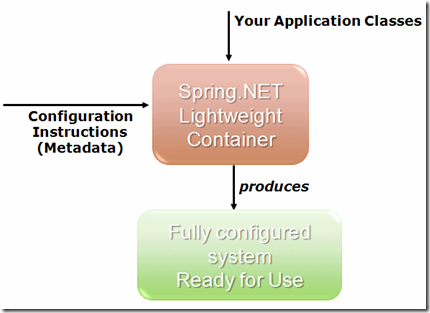什么是IoC
如何使用Spring.NET的IoC功能
翻译一段文档中的原话做为IoC使用的开始,由于水平所限,是否完全正确,就不要过于深究的……
The Spring.Core assembly is the basis for Spring.NET's IoC container. The IObjectFactory interface provides an advanced configuration mechanism capable of managing any type of object. IApplicationContext is a sub-interface of IObjectFactory. It adds easier integration with Spring.NET's Aspect Oriented Programming (AOP) features, message resource handling (for use in internationalization), event propagation and application layer-specific context such as WebApplicationContext for use in web applications.
Spring.Core提供的基础的Spring.NET IoC 容器的功能。IObjectFactory接口提供一种能够管理任何类型对象的高级的配置机制。IApplicationContext是IObjectFactory的一个子接口。它增加便于整合Spring.NET 的AOP特性、信息资源处理(用于国际化),事件的传播和应用于应用程序,就像WebApplicationContext用于网络应用程序。
这段话中告诉我们两点最有需要知道的:
- 要引用 Spring.Core
- 要在代码中使用 IObjectFactory 的某个子项
使用步骤:
- 引用 Spring.Core
- 建立配置文件(可以写在App.config中)
- 将配置文件读入程序
- 使用GetObject方法完成实例化过程
- 使用实例
- id : 这里我把它看成是类的映射名称。因为在IoC中主要是使用反射的机制来实现的,所以这里可以看成是那个提供给反射的字符串。
- type : 这里有两项,第一项是真正用于注入的那个「类」,第二项是程序集名称。
- 括号中可以是一个配置文件,也可以是多个。个数的多少主要看实际的需要。
- 配置文件的路径要是Debug文件夹中的。
参考代码
<objects xmlns="http://www.springframework.net"> <!-- <import resource="services.xml"/> --> <object id="AccVipDao" type="newpos.dao.impl.emax.TAccVipDA, newpos.dao.impl.emax"> <!-- collaborators and configuration for this object go here --> </object> <!-- more object definitions go here --> </objects>
namespace newpos.test { class Program { static void Main(string[] args) { IApplicationContext context = new XmlApplicationContext("Objects.xml"); IAccVipDao vip = (IAccVipDao)context.GetObject("AccVipDao"); TAccVip vipInfo = vip.GetDataAllByVipNo("123456"); Console.WriteLine(vipInfo.EnterDate); Console.ReadLine(); } } }
其他
|
Property |
More info |
| type | Section 5.2.5, “Instantiating objects” |
| id and name | Section 5.2.4.1, “Naming objects” |
| singleton or prototype | Section 5.4, “Object Scopes” |
| object properties | Section 5.3.1, “Dependency injection” |
| constructor arguments | Section 5.3.1, “Dependency injection” |
| autowiring mode | Section 5.3.6, “Autowiring collaborators” |
| dependency checking mode | Section 5.3.7, “Checking for dependencies” |
| initialization method | Section 5.6.1, “Lifecycle interfaces” |
| destruction method | Section 5.6.1, “Lifecycle interfaces” |
